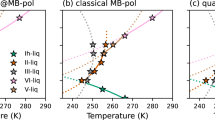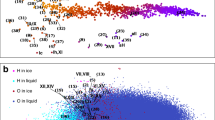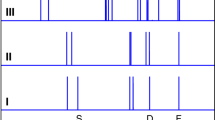Abstract
Hydrogen-bonded structures display wide ranges of the various angles (such as O—H…O) and distances (such at H⋯O) used to describe their intermolecular geometry. For example, O⋯O distances are found to vary between ∼2.5 and 3.2 Å, and the hydrogen bond angles normally vary between 120 and 180°. Although correlations between distances and angles may be found (for example, between H⋯O distance and O—H⋯O angle), these geometrical characteristics are generally too ‘soft’ to be used as stereochemical restraints in, for example, refining the solvent structure in protein crystals. Moreover, although many potential functions exist for describing water–water interactions, none of them is totally satisfactory in reproducing experimental results, even for pure water1. We present here the initial results of an analysis of water structures in high-resolution neutron crystal structures2 which is much more successful in rationalizing the stereochemistry of water interactions. Rather than considering the structures in terms of weak, orientation-dependent attractions, a concentration on the repulsive interactions leads to a set of very much stronger stereochemical constraints, which not only rationalize the structures but appear largely to control the orientational correlations in aqueous systems. Looked at this way, water network structures in crystal hydrates and, we suspect, in the liquid itself, become for the first time comprehensible. The approach provides a much firmer base from which to build realistic potential functions to model and simulate solvent structures.
This is a preview of subscription content, access via your institution
Access options
Subscribe to this journal
Receive 51 print issues and online access
$199.00 per year
only $3.90 per issue
Buy this article
- Purchase on Springer Link
- Instant access to full article PDF
Prices may be subject to local taxes which are calculated during checkout
Similar content being viewed by others
References
Finney, J. L., Quinn, J. E. & Baum, J. O. in Water Science Reviews Vol. 1 (ed. Franks, F.) 93–170 (Cambridge University Press, 1985).
Savage, H. F. J. in Water Science Reviews Vol. 2 (ed. Franks, F.) (Cambridge University Press, in the press).
Olovsson, I. & Jönsson, P. G. in The Hydrogen Bond Vol. 2 (eds Schuster, P., Zündel, G. & Sandorfy, C.) 393 (North-Holland, Amsterdam, 1976).
Klar, B., Hingerty, B. & Saenger, W. Acta crystallogr. B 36, 1154–1165 (1980).
Savage, H. F. J. Biophys. J. (in the press).
Hamilton, W. C. & Ibers, J. A. Hydrogen Bonding in Solids (Benjamin, New York, 1968).
Bacon, G. E. Neutron Diffraction 355 (Clarendon, Oxford, 1975).
Savariault, J. M. & Lehmann, M. S. J. Am. Chem. Soc. 102, 1298–1303 (1980).
Dam, J., Harkema, S. & Feil, D. Acta crystallogr. B 39, 760–768 (1983).
Hermansson, K. & Thomas, J. O. Acta crystallogr. C 39, 930–936 (1983).
Author information
Authors and Affiliations
Rights and permissions
About this article
Cite this article
Savage, H., Finney, J. Repulsive regularities of water structure in ices and crystalline hydrates. Nature 322, 717–720 (1986). https://doi.org/10.1038/322717a0
Received:
Accepted:
Issue Date:
DOI: https://doi.org/10.1038/322717a0
This article is cited by
-
Hydration of the carboxylate group: Anab initio molecular orbital study of acetate-water complexes
Structural Chemistry (1997)
Comments
By submitting a comment you agree to abide by our Terms and Community Guidelines. If you find something abusive or that does not comply with our terms or guidelines please flag it as inappropriate.



